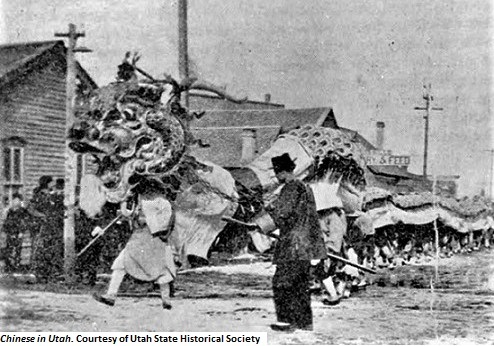Dublin Core
Title
Description
Celebrations of the Chinese Lunar New Year have riveted Utahns since 1869.
When Chinese immigrants first came to Utah to build the railroad in 1869, they brought one of their most important holidays, the Chinese Lunar New Year, a 15-day festival that celebrates the coming spring and marks a time of renewal.
To start the New Year with a clean slate, Chinese workers in the railroad camps of northern Utah would pay all their debts, and the camp cook would prepare hot water for baths. A midnight feast of abalone and other special foods was followed by a day of fasting from all meat.
The Chinese tradition of Hongbao was also observed, where older people gave money to children in red envelopes. The contents were known as "lucky money." William Louie, the grandson of a Chinese railroad worker, remembers the generous Chinese men giving out lots of “lucky money” to the children of Ogden. Henry Ju shares similar memories of Salt Lake City’s Chinatown in the 1930s. He recalls that, “On [Chinese New Year] they had a big … celebration … in Plum Alley and they'd invite the police chief and mayor and all the dignitaries and they'd set around there and eat all the goodies and some of [the old Chinese men] would come over and give us [kids] the red envelopes with money in them; …That was quite a haul [because] they used to give silver dollars.”
Ivy Towler has vivid memories of Chinese New Year parades in downtown Salt Lake during the 1890s. She describes, “ the huge Chinese dragon, two hundred feet long, which progressed along the street like a gigantic centipede. The dragon itself, which swayed from side to side, had a head six feet tall spitting fire from its vicious red mouth.”
Until its demise in 1940, Salt Lake’s Chinatown hosted many celebrations of the Lunar New Year, which attracted hundreds of Salt Lakers from all walks of life, who came to enjoy the elaborate feasts, the smell of burning incense, and the continuous popping of firecrackers.
Creator
Source
Image: Chinese in Utah. This photo was used in the book, "The Peoples of Utah," (1976). Chinese Dragon in parade. Courtesy of Utah State Historical Society.
________________
See Miriam B. Murphy, “Celebrating the New Year in Salt Lake’s Chinatown,” History Blazer, January 1996, accessed via http://historytogo.utah.gov; Don C. Conley, “The Pioneer Chinese of Utah,” The Peoples of Utah, ed. Helen Z. Papanikolas (Salt Lake City: Utah State Historical Society, 1976); Deseret Evening News, February 8, 1902; Salt Lake Tribune, February 15, 1972; Interview with Henry Ju, December 3, 1974, Magna, Utah; Kate B. Carter, comp., "The Early Chinese of Western United States," Our Pioneer Heritage, 17 vols. (Salt Lake City, 1958), 10:456.

